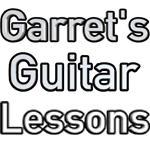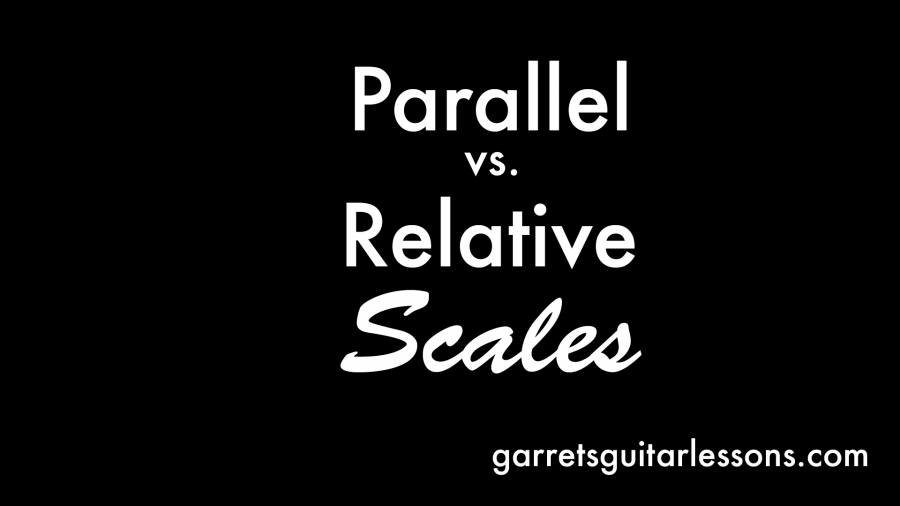What’s a Scale?! Well if you click that link I’ll talk more about how to build scales, but I’m mostly going to be talking about the difference between Parallel vs. Relative scales and each of their pros and cons.
Relative Scales
Relative means scales that are “related” by the notes within the scale, but have different root notes.
Example:
C Major (C-D-E-F-G-A-B-C) and A Natural Minor (A-B-C-D-E-F-G-A)
C Major (C-D-E-F-G-A-B-C) and E Phrygian (E-F-G-A-B-C-D-E)
C Major (C-D-E-F-G-A-B-C) and G Mixolydian (G-A-B-C-D-E-F-G)
You are “relating” the scales to other scales that share the same notes within the scales, but have different roots.
Pro: Great way to think about playing scales without having to learn new scale patterns.
Cons: Have to think of a different root note than what you’re playing, which often leads to wrong notes being played. Phrasing can be weird due to you thinking of a different root note. Chord tones move from your original scale pattern, dependent on which degree your basing your “new” scale from.
Parallel Scales
Parallel Scales are scales that share the same root note, but have different notes within the scale.
Example:
C Major (C-D-E-F-G-A-B-C) and C Natural Minor (C-D-Eb-F-G-Ab-Bb-C)
C Major (C-D-E-F-G-A-B-C) and C Phrygian (C-Db-Eb-F-G-Ab-Bb-C)
C Major (C-D-E-F-G-A-B-C) and C Mixolydian (C-D-E-F-G-A-Bb-C)
Pros: Each scale has it’s own pattern. Phrasing is easier as you always relate it to the root. You learn what makes each scale unique. Visualizing where scale degrees becomes easier with each new scale you learn. Chord tones stay consistent throughout scale patterns.
Con: You have to learn more scale patterns.
I use a variety of ways to look at scales within my video lessons, based on the needs and goals of my intended audience, as there is no right or wrong way. I personally find the relative scales are great for people that don’t want to learn a bunch of scale positions but want to play the same pentatonic for Major and Minor positions (I refer that as “Index on the Minor” and “Pinky on the Major” for my 1-3 1-3 Slide Scales for example). It’s very useful in some situations and necessary to understand minor tonality.
Relative scales are not a very effective way of playing across the neck however. I have used ”CAGED” as a streamlined way to think about our neck throughout this entire website and I’m sticking to it, but there are other ways to organize our fretboard. The big thing is that when you hear something like a “G Mixolydian” scale, you don’t want to have to think… “What is G the fifth degree of? Oh, C! Okay where is C closest to me? Cool I just have to play C Major scale now”. Not only are you adding an extra step (or 3) but you’ll find that it doesn’t sound very Mixolydian.
Which brings me to my next point…
Scales are not only how we play them, but how we hear them. Often, playing “C Major” for a G Mixolydian sound is not going to get you the sound you want, because of how you’re thinking about it. C Major and G Mixolydian have different root notes which means each note we play reacts differently to C Major verses G Mixolydian. Your C Major licks will not sound great in G Mixolydian, even though the scales share the same notes.
Why?
Let’s take a look at just one note… how about the B note! The B note is the 7th note of C, which in a pop context can sound to distant or close to the root note. In C, that one is going to want to resolve to C. B is the 3rd of G Mixolydian, so the B note is the resolved note of G. That’s just one note. To think about how each note reacts differently to what root note might take a little more thought than just “play C scale for G Mixolydian”.
So what do you do then?
The definite pro of thinking in terms of “Parallel” scales is that you relate everything to the same root, so the notes that are good over a G chord will be the same for each Major Mode. You do have a lot more scale patterns to learn, but knowing what differentiates the Major scale from the Mixolydian scale is good to know! There’s a reason theat Mixolydian scale is being called for and most likely it’s that note which will make it sound more distinct.
The other huge pro of thinking in terms of Parallel Scales is that you inherently have to think about each step of the scale as how it relates to the root and how it separates itself from other Modes. It takes some time, but the good thing about guitar is that it’s very visual. Once you get familiar with where the 7th is in one scale shape, the 7ths don’t change (in relation to the root), regardless of what key you’re in. You do have 7 positions to worry about, but it’s great ear training and can be very useful if you decide to jump in to Target Note (or Chord Tone) soloing.
There’s not a right a wrong way. As I mentioned before I do go through a bit of both throughout the site (although I definitely refer to Parallel scales much more). If you find yourself doing the mode dance (Mixolydian, G Mixolydain, What Scale is G the fifth of?) often enough, take the time to work through parallel scales to really see and hear what separates that scale from the rest.

